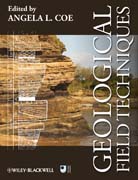
As there is currently no single up-to-date publication on geological field techniques on the market, The Open University is looking to develop and copublish a textbook that covers the broad spectrum of tasks completed during geological field work. Geological Field Techniques will show how to make geological field observations and collect primary geological data rather than teaching model-driven data collection. In particular the book will cover the purpose of collecting different types of field data and what is appropriate for different situations and outcomes. The text of around 35,000 words will be integrated witharound 200 illustrations. It is estimated that there will be about 80 photographs ( up to 25% of which will be annotated), including many photographs of real field notebooks and field slips. The artwork of more than 100 illustrationswill be prepared by the University. The book will include an appendix of useful diagrams and tables for recognition of geological features, rock types and classification. After a brief introduction the book will cover field safety and equipment before exploring the purpose of the fieldwork and how to start. One substantial chapter will be devoted to the production of a field notebook asit is the key record of geological field data. The bulk of the book will comprise five chapters covering the necessary skills for the collection of paleontological, sedimentological, igneous, structural and metamorphic data. Buildingon these previous five chapters will be a chapter on geological mapping. The book will conclude with chapters on recording numerical data, photography and sampling. Pedagogical themes and aspects Geological Field Techniques will include short worked examples illustrating the practical points of the preceding text. These will include some examples with more than one interpretation from the data available. The example will also indicate what additional information is required to decide between competing interpretations (which of course, in practice, it may not be possible to collect). This style will be used to demonstrate the need to take into account the fact that geological data sets are often incomplete and to encourage further enquiry. The main chapters will have a similar format and structure. For instance, they will start with an explanation of the bigger picture and why one might wish to collect this type of data, and information on field equipment. Some questions and answers will be includedin the text to encourage the reader to reflect on preceding information or ona figure. It is proposed that the book should contain several design featuresto help navigation and ease of access of information for instance: • tricks of the trade with suitable icon. These will cover less obvious practical pointse.g. use of a book or clipboard and fluid for uneven surfaces when measuring strike/dip • flow chart type diagrams to summarize the key stages in each of the data collection processes • colour coding for each chapter • extensive cross-referencing. Geological Field Techniques will assume an understanding of themain concepts and theory in Geology. For instance, it will be assumed that the reader knows how to identify minerals in hand specimen, and has knowledge ofrock classification, geological processes and the main geological terms. The book will however contain an appendix summarizing key features and classification schemes. It is also proposed that an associated online illustrated geological glossary could be provided. Supplementary online material Student exercises and an electronic glossary of basic geological terms will be provided on theOU student website and could be made available for the publishers resource website. A detailed chapter outline (Appendix I), a sample of extracts (AppendixII) and examples of drawn artwork (Appendix III) are enclosed.
- ISBN: 978-1-4443-3062-5
- Editorial: Wiley-Blackwell
- Encuadernacion: Rústica
- Páginas: 323
- Fecha Publicación: 24/09/2010
- Nº Volúmenes: 1
- Idioma: Inglés
